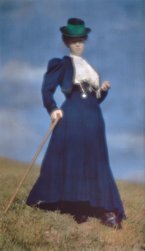What do you think?
Rate this book


320 pages, Paperback
First published October 23, 2012


Dies ist ein schönes Buch, in mehrfacher Hinsicht. Allein schon sein Einband ist Programm. Er zeigt eine Aufnahme von Heinrich Kühn, der schon zu Beginn des 20. Jahrhunderts mit Hilfe des Autochrom-Verfahren kunstvolle Farbfotos erschaffte. Ein Lesebändchen erhöht den gediegenen Eindruck. Im Innern ist jedem Kapitel (in diesem Falle Monat) ein Schwarzweißbild vorangestellt, das mit dem Text in direkter Beziehung steht, häufig sogar ein direkt besprochenes Ereignis oder Bild zeigt, so beispiels¬weise den Dichter Georg Trakl am Strand des Lido oder das Fahrrad-Rad von Marcel Duchamp, das erste „ready-made“ Kunstwerk der Welt. Duchamp, nebenbei bemerkt, ist eine der bemerkens¬wertesten Künstlergestalten, die dieses Buch bevölkern. Als einer der Väter des Kubismus brach er nach dem Erfolg seines Bildes „Akt eine Treppe herabsteigend Nr. 2“ auf der Armory-Show in New York mit dieser Stilrichtung und zog sich später sogar ganz vom Künstlerdasein zurück und wurde halb-professioneller Schachspieler und Ausstellungsorganisator.
Das gesamte Buch selbst tritt auf wie ein Gemälde, allerdings nicht aus der Zeit der Moderne und des Expressionismus, dem es so viel Raum gönnt, sondern im Stile des Pointilismus, der aus vielen kleinen Fragmenten ein breites Bild des Jahres 2013 aufzeichnet. Dabei stehen die Malerei und Literatur im Zentrum des Interesse des Autors, aber auch die Psychoanalyse, namentlich Freund und C.G. Jung bekommen ihren Platz, ebenso wie einige anekdotenhaften Ereignisse, wie der erste Auftritt von Louis Armstrong (im Orchester der Besserungsanstalt) oder die erste „funkentelegraphische“ Verbindung zwischen Amerika und Europa. Insbesondere von dem Dichter Rainer Maria Rilke und dem Maler Ernst Ludwig Kirchner entstehen eindrücklich Portraits.
Jedem allseits interessiertem Leser sei dieses Buch des ehemaligen Feuilletonchefs der Frankfurter Allgemeinen Zeitung und Der Zeit wärmstens ans Herz gelegt. Allerdings möge er oder sie einen Computer oder Tablett in Reichweite haben um die Kunstwerke in Augenschein zu nehmen, um die sich diese Geschichten ranken.
“In it [The Great Illusion] Angell expounds his theory that the era of globalization renders world wars impossible, because all countries are now economically interlinked to such a high degree ... close international ties in communication and above all in the world of finance mean that any war would be preposterous. ‘The entire German financial world would exert its influence over the German government, thereby putting a stop to a situation which would be ruinous for German trade’”(and how relevant is that to today?)